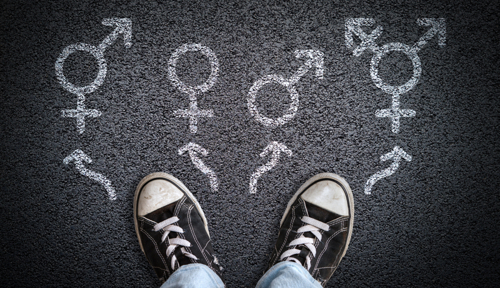
Do sex chromosomes determine differences in traits like height, bone structure, and physical strength?
January 29, 2025

- Related Topics:
- Complex traits,
- Genetic sex,
- Y chromosome
Lou from Utah asks:
"Do sex chromosomes determine physiological development such as height, bone structure, physical strength?"
When thinking about physical development, it is crucial to remember that sex chromosomes are just one of many factors at work.
The X and Y chromosomes are our two sex chromosomes. People with two X chromosomes are generally female, while people with an X and a Y chromosome are generally male.
Now, I did say “generally male” and “generally female”. It may surprise you, but it can actually be way more complicated than that!
Typically, eggs and sperm contain one of each chromosome so that when they come together, we get two copies of each. However, some people have different combinations of sex chromosomes, like XXX, XXY, XYY, or just X. In these cases, biological sex is still typically based on the presence or absence of a Y chromosome. It’s important to note that biological sex is not the same thing as gender identity.
How are X and Y chromosomes related to sex differences?
The X chromosome contains a lot of generally important instructions, which is why everyone has at least one X chromosome. The Y chromosome, on the other hand, is smaller and contributes to the anatomical differences we see at birth.
One of the most important genes on the Y chromosome is SRY. When this gene is expressed in a developing embryo, it causes male reproductive structures to form. If this gene is not expressed, then female reproductive structures form instead. This means someone can have a Y chromosome but appear female if a mutation prevents SRY from being expressed.
Similarly, someone can be XX and appear male at birth. This is rare, but it happens when the SRY gene gets attached to an X chromosome during meiosis.

It gets more complicated though- there are plenty of cases where the presence or absence of SRY expression does not account for the sex someone is assigned at birth.
Sex chromosomes are only one part of the story
Some people are intersex, meaning they were born with anatomy that is more ambiguous than what we typically think of as male or female. This is not usually related to SRY, so what other factors are at play here?
Hormones! Especially a hormone called testosterone.
Someone with two X chromosomes may be intersex if they inherited a condition causing them to produce higher levels of testosterone, or if their mother had higher levels of testosterone when they were developing. Someone with X and Y chromosomes may be intersex if they aren’t able to produce typical levels of testosterone, or if their cells aren’t able to respond to testosterone.
So, we’ve seen that both sex chromosomes and hormones are responsible for differences in reproductive anatomy, but what about differences in traits like height, bone structure, or physical strength?
Subtle differences in some of these traits can be seen before birth. It’s possible that the X and Y chromosomes contribute to this, but so far research points to the placenta.
The placenta expresses genes that help fetuses grow, and studies have found that this can differ based on the sex of the fetus. For males, gene expression is more focused on growth1, so at birth, they tend to be longer and heavier than females. These height and weight differences aren’t permanent though. By the time kids are in preschool, height doesn’t differ based on sex.
Puberty ushers in a lot of change
If you think about it, many sex-specific differences don’t really show up until puberty starts. Before that, individual differences in height and body shape are largely related to complicated interactions between a lot of genes that have nothing to do with biological sex.

So, why does puberty bring about so many changes?
Once again, the answer is hormones!
Everyone has the same hormone genes. But how much of each hormone is made is influenced by a person’s anatomy.
Estrogen is mainly made in the ovaries, while testosterone is mainly made in the testes2. In this sense, X and Y chromosomes play an indirect role in sex-related differences since they impact which of these structures develop.
The importance of estrogen and testosterone become really clear to us if we think about how puberty blockers work. This type of hormone therapy is commonly used to help kids who start puberty at a really young age. It works by preventing increased production of estrogen and testosterone, which effectively puts puberty on “pause” until the therapy stops.
It is important to note that estrogen and testosterone are produced by multiple organs, so males still produce estrogen and females still produce testosterone. In fact, estrogen is actually made from testosterone and other androgens!
How do hormones affect our height?
Bone growth plays a large part in determining height. If your bones keep growing for a long amount of time, you’ll end up taller than if they only grew for a short amount of time.
Estrogen is necessary in order for bones to get longer, so higher levels of estrogen early on in puberty leads to early growth spurts. However, when estrogen levels get high enough, bone growth stops. This means that someone with lower levels of estrogen won’t grow as fast as someone with higher levels of estrogen, but they will be able to keep growing for a longer period of time. Since males tend to have lower levels of estrogen, they typically grow taller3.
Estrogen isn’t the only factor affecting height though. Many genes contribute to how tall someone ultimately is4.

What about bone structure?
Bone structure is impacted by a group of hormones called androgens, which includes testosterone. Higher levels of androgens cause bones to become wider, with thicker outer layers that can tolerate more stress. Males tend to have higher androgen levels, so their bones tend to be a bit stronger5.
How about physical strength?
Estrogen and testosterone play key roles in shaping how much fat versus muscle mass we have. Higher levels of estrogen tend to increase fat mass, while higher levels of testosterone tend to increase lean muscle6.
Of course, it’s important to remember that differences in strength are greatly impacted by the types of physical activities we do! Someone with higher levels of estrogen who spends a lot of time at the gym may be stronger than someone with higher levels of testosterone who spends a lot of time on their couch.
Impacts of variations in hormone levels
Hormone variations outside of puberty can also impact physical traits.
For example, some males naturally have high levels of estrogen. This may be due to a range of genetic conditions, stress, weight, or certain medications. And with increasing age, testosterone levels decrease while estrogen levels increase. Higher levels of estrogen can cause breasts to get larger and body hair to decrease.
Similarly, some females may have high levels of testosterone. Like high estrogen in males, high testosterone in females can have a wide range of effects. Some of the most noticeable impacts are increased facial hair and muscle mass, as well as a deeper voice. Estrogen levels are also impacted by aging in females, and the sharp decline in estrogen that happens as a result of menopause causes changes ranging from hair loss to increased cardiovascular risk.
Gender-affirming hormone therapy
Throughout this article, the terms male and female have been used in reference to biological sex related to sex chromosomes and anatomy. However, biological sex and gender identity are not the same thing, and for some people, they are not aligned.
When there is a mismatch between biological sex and gender identity, people can experience a lot of distress and feel uncomfortable in their bodies. This is called gender dysphoria.

We’ve seen how hormones like estrogen and testosterone play a big role in shaping our appearance, muscle mass, and even our bone structure. Gender-affirming hormone therapy can be used to help people feel more comfortable in their bodies as their physical features reflect their actual gender identity.
Masculinizing therapy involves taking testosterone, while feminizing therapy typically involves taking estrogen and androgen blockers.
Similar to what we saw earlier, increases in testosterone due to hormone therapy causes people to develop what we think of as “masculine” traits, such as a deeper voice and more facial hair. Hormone therapy that increases estrogen while blocking androgens results in what we think of as “feminine” traits, such as breast development and decreases in body hair.
After considering the many factors involved in physical differences often associated with males and females, we can see that these differences are mainly due to hormones rather than sex chromosomes. Since hormone levels can vary among individuals and change over time, the association between these physical differences and sex chromosomes should be treated as a pattern rather than a rule.

Author: Ruth Schade
When this answer was published in 2025, Ruth was serving as The Tech Geneticist, answering questions submitted from around the world and curating articles for Ask-A-Geneticist. Ask-A-Geneticist is part of the Stanford at The Tech program, which brings Stanford scientists to The Tech Interactive to facilitate genetics activities in the BioTinkering Lab.
 Skip Navigation
Skip Navigation
